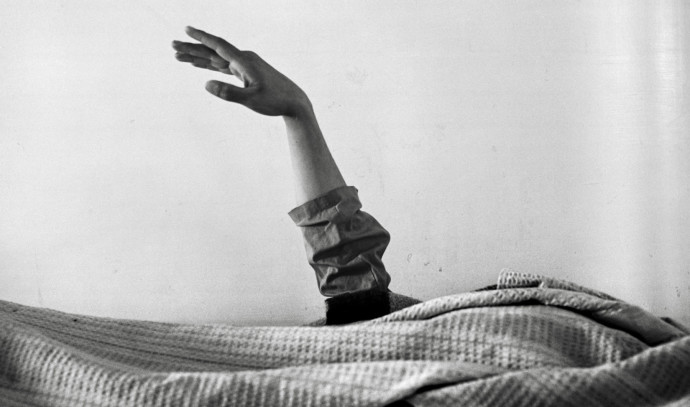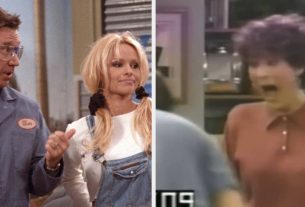The art of photography has taken a bash or two over the last couple of decades, thanks to technological advancements. Today, we are all “photographers.” All we need to do is whip out our cell phone and merrily snap away. We are now at a stage in the evolution of human consciousness, social awareness and simply experiencing everyday life whereby we are more than likely to instinctively document some event or incident with our phone camera than be in the moment itself, and store it away in our corporeal and emotional memory banks.
One of a special ilk
Then there are the professional engaged folk who make a point of capturing people and situations in a far more compelling and meaningful way. Raed Bawayah is one of that special ilk. His current exhibition at the Alexander Pavilion of Eretz Israel Museum in Ramat Aviv is called, in English, Black Life White Art, overseen by the museum’s chief photography curator Guy Raz.
That, naturally, references the fact that the show features monochromic prints. But it may also have something to do with a clear-cut, simplistic view of life that goes along the divisive lines of “I’m right and they’re wrong.”
The Hebrew title translates as Black Is Life, White Is Art, which conveys a very different sensibility and subtext. Either way Bawayah clearly has a street-level – or, basement-level – grasp on real, palpable, even feral life. That is displayed, in black and white and in no uncertain terms, on the walls of the show space.
Bawayah’s subjects range from members of the Romani community, to Egyptian farmers, Austrian schoolchildren, youngsters in remote Russian villages, Taiwanese fishermen and Colombian ladies of the night.
The 52-year-old Palestinian has surely “been there and done that” across the globe, and has been a resident of Paris, France for most of his life. But Bawayah’s most compelling work is, naturally, the portraits he so lovingly and compassionately created of his fellow Palestinians.
Miracles do happen
THE PICTURE of his own mother, Fatma, is as good a place as any to begin delving into Bawayah’s intimate local-centric works in the exhibition. The portrait was taken in the West Bank village of Katanna, a stone’s throw from Har Adar, where Bawayah was born and lived until he relocated to France.
“It is a person’s right to live, the obligation of the photographer to photograph, the curator is duty bound to curate, and the spectator has the right to observe,” says Raz as an overarching declaration of intent before we get into the extensive collection. More specifically, and poignantly, Raz directs me to the Fatma diptych. “The right hand one was taken in 2014, and I asked Bawayah to take a contemporary one in the run up to the exhibition,” he explains. The former shows the photographer’s mother in profile, in a supplicatory pose. The more recent picture has her head on with a world-weary expression. “She has seen her son grow up to what he is today,” Raz adds. She has also seen a lot more.
Bawayah has come a long way from his penurious, challenging, pastoral beginnings. Now a bona fide member of the global arts community, with an impressive exhibition roster, the show in Ramat Aviv is proof that miracles do sometimes happen.
With a backdrop like his, one might expect Bawayah to let off some steam in his work, to scream about the injustice of his rocky road, the political and personal difficulties he has had to negotiate to get where he now is, and the simple fact that he now lives in exile, albeit in one of the world’s cultural epicenters.
You don’t get any sense of that from the prints. Yes, some of the people in the photos have patently gone through their fair share of suffering. Yes their living space seems anything but comfortable and supportive but there is nothing melodramatic about his portrayals. There is no emotional blackmail, no finger-pointing sentiment.
He approaches his subjects tenderly, respectfully and with empathy. That comes across most palpably in the Deadline series, taken at a psychiatric hospital in Bethlehem. One picture shows half a dozen inmates, evidently the worse for the emotional wear. There is no attempt to dramatize or cheapen their predicament. In the hands of a mainstream media snapper, the group would have been captured in far more suggestive poses, with sensationalist visual hyperbole the order of the day. By – if anything – understating the patients’ circumstances, he allows us to meet them halfway, to relate to them as human beings with a story, one worth hearing.
Tinges of despair and defiance
CHILDHOOD MEMORIES is another evocative series. One triad of youngsters at play, or just hanging out, is particularly moving. It is as puzzling as it is intriguing. These are children who clearly live on the wrong side of the socioeconomic and political tracks. You catch tinges of despair and hopelessness as they stare into a bleak unseeing horizon, or look defiantly or wonderingly into the camera, but that comes across as a statement of fact, a documentary vignette. Bawayah casts an understanding, compassionate observational eye across the people and scenes he encounters,
Considering his trying origins, it is nothing short of astounding that Bawayah has made it to the upper echelons of his creative sector. The Katanna you see in some of the prints is still home to the Paris-based photographer, in a pure heartfelt sense. It was from here that he made his daily arduous journey into Israel, taking on all kinds of odd jobs to try to keep his family fed after his father died when Bawayah was only seven years old. “He was a shepherd at the time,” Raz says. “He had a mother and eight siblings he had to help support.”
It was while he was trying to make a crust, as a laborer in the Old City of Jerusalem, that he caught sight of tourists with cameras hanging from their necks, merrily capturing holiday snapshots. “He was totally mesmerized,” Raz continues. “He developed a burning desire to discover what that thing was.”
A woman whose house he cleaned every week, as part of his efforts to keep the family afloat, heard about Bawayah’s passion for photography and referred him to the Naggar School of Photography, Media, and New Music in Musrara where founder-director Avi Sabag took him under his wing and did his best to help nurture the Palestinian’s latent gifts.
The improbable tale goes on, with Bawayah spending three years at the Musrara school, slap bang in the middle of the Second Intifada. He graduated and blossomed into what Raz calls; “one of the most exciting photographers in the world today.” That is high praise indeed. Judging by the Black Life White Art exhibits it is fully deserved. “This is a story that defies fantasy,” Raz chuckles. “He is completely authentic. He has lived the life he photographs. He is not looking in from the outside. This is all completely natural.” And thoroughly convincing and compelling. Prepared to be moved.
Black Life White Art closes on May 27. For more information: (03) 641-5244 and https://www.eretzmuseum.org.il/



